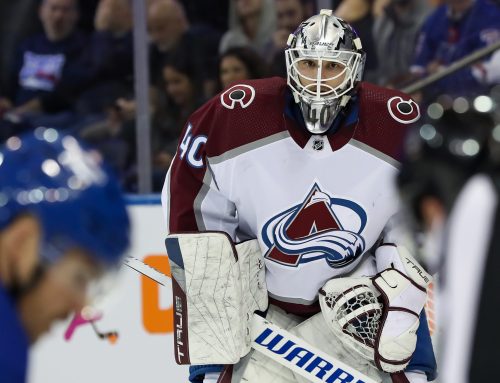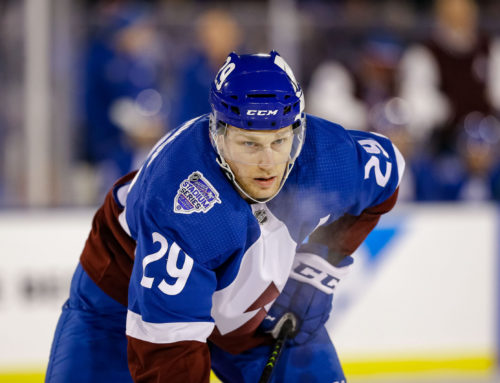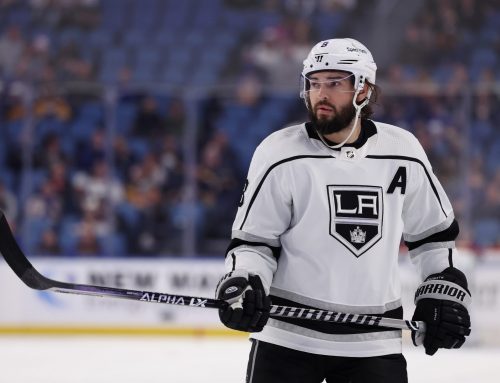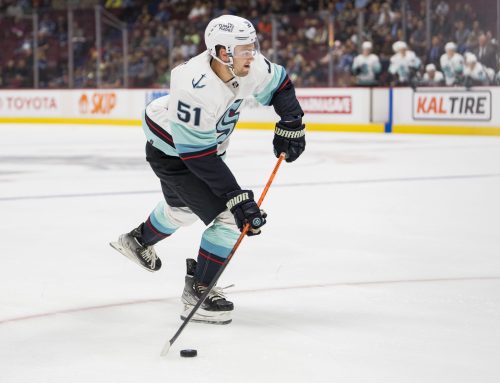Best in the West: Left Wing (16-17)
Doran Libin
2016-08-15

The 10 best left wingers in the Western Conference for fantasy hockey.
The weighting and the focus this week does not change much except for shifting sides of the ice. This was the ranking thus far with the most change as Andrew Ladd and Taylor Hall left the Western Conference and there was a bit of an injection of youth with two second year players making their debut as well as one more youngster.
Honorable Mentions:
Zach Parise still averages more than three shots per game but his shot rate has been falling for four consecutive years. During the lockout season he took 11.11 shots per 60 minutes at even strength whereas last year he took 8.89 shots per 60. Last year he was saved by his 10.14 shooting percentage at even strength, which was high for that situation but overall his shooting percentage was actually a little low for him. He has managed to keep his goal rate relatively consistent due to improved shot quality but that can only last so long. He will still get more than 50 points but beware of this trend. Patrick Sharp relies largely on his power play time and his time on the Benn/Seguin line for his points. He got almost half his points on the power play and 56% of his even strength points while with Benn and Seguin. The problem for Sharp is that he only plays half of his even strength minutes on the Benn/Seguin and there is drastic drop off from the Benn/Seguin line to his second most common linemate Cody Eakin, whom he played with almost thrice as much as he played with Jason Spezza, this will keep him from pressing 60 points. Robby Fabbri started last season well but cooled down significantly from February on. Despite his depressed late season rates he got more ice time in March and April than at any other time in the season, which shows that he grew on Hitchcock. With a full season under his belt, and more minutes seeming very likely, Fabbri will break 50 points this season as he should get more offensive opportunities with Brouwer and Backes being replaced by David Perron and Vladimir Sobotka.
10. Max Domi
Max Domi had the second highest points per 60 rate at even strength on the Coyotes but the highest primary points per 60 rate at even strength. He also had the second highest point per 60 rate on the power play behind only Oliver Ekman-Larsson (OEL), and a top 50 primary point rate in the league. Despite his production rate Domi only averaged 16 minutes per game, which should go up this year with the Coyotes getting younger this year. The departure of MIkkel Boedker will also free up power play time for Domi, as Boedker averaged almost as much power play time as OEL while with the Coyotes last year. In March and April after the Coyotes made their trade deadline moves Domi averaged 17 minutes of ice time per game. During that time Domi also averaged three minutes of power play time. With more ice time, and a full season under his belt, look for Domi to shoot more as well this coming season. Domi always has had a balanced goal to assist ratio but there are limited options on the Coyotes and Domi shooting more would make sense. The influx of added talent on the roster this year bodes well for Domi, especially when Hanzal gets his annual 20 game injury vacation.
9. Milan Lucic
Do not over overrate the potential bump Lucic will receive from playing with Connor McDavid. Lucic was on the ice for more than three goals per 60 minutes at even strength last year, as he has been for the four of the last six years. No player in the league was on the ice for even four goals per 60 minutes, with Jagr leading the league being on the ice for 3.78 goals per 60 minutes, while only one other player was on for more than 3.5 goals per 60 minutes. While McDavid had the fifth best goals for per 60 minutes in the league, he was only on the ice for a quarter of a goal more 60 minutes than Lucic. As Lucic played just under 1200 minutes last year with an individual point percentage (IPP) of 65% that works out to an extra three points for Lucic if he even plays with McDavid. That suggests that unless one believes that adding Lucic to the McDavid line will produce Crosby-like production from the lockout season, 5.2 goals for per 60 minutes, it is best to pretty much expect the status quo from Lucic with maybe a slight bump. Lucic does not drive play he picks up the garbage, hence the low shot rate and high shooting percentage. For that reason Lucic’s high shooting percentage last year is not a huge concern as his career average is just under 15%.
8. Patrik Laine
Spoiler alert: Laine is the sole rookie on the list.
He could not have asked for a much better situation than getting drafter by the Jets. Between the emergence of Mark Scheifele as legitimate number one center and the presence of Bryan Little, who remains a borderline number one center, Laine cannot lose regardless of the line on which he gets placed. Scheifele was on the ice for 3.41 goals per 60 minute at even strength and Bryan Little was on the ice for 2.65 goals per 60 minute. That suggests that Laine would be better off with Scheifele but Little was on the ice for 3.12 goals per 60 minute when on the ice with Blake Wheeler and Andrew Ladd. Basically both the Jets top two centers have the ability to drive offense at a level that would place them in the top 20 in the league. If Laine was able to produce an IPP of 65% he would produce at least 45 points, assuming a full season with 15 minutes per game at even strength, at if he replaced Ladd on the Little line or 50 points if on the Scheifele line, and that is without a ton of power play time. If that seems like a stretch an IPP of 65% ranked 230th in the league amongst forwards who played more than 300 even strength minutes.
– – – Order Dobber's 11th annual Fantasy Hockey Guide right now and receive a 'FREE' Fantasy Football Guide! – – –
It should come as no surprise that Landeskog produces better when on the ice with Nathan Mackinnon as opposed to Carl Soderberg. The problem last year was that he played a roughly even amount with center. Which is to say that a coach with a better conception of which lines work well together should help Landeskog, or Patrick Roy’s resignation should be a plus for him. Whether it is averaging less than three minutes per game on the power play or being used in a checking role, Landeskog was used in a sub-optimal role by his now former coach. This coaching change could result in Landeskog’s best season since his second year in the league as Landeskog has gotten worst in every year under Patrick Roy. All signs point to Landeskog returning to pretty close to his 2013/14 form when he produced 65 points on nearly three shots per game.
6. Daniel Sedin
I have a bad track record with the Sedins as I have been predicting their big drop off for the last three years. Daniel Sedin should suffer a greater drop-off than his brother because Henrik plays a style that is more conducive to producing well into his career, see Joe Thornton, an elite pass-first player. It probably helps that Daniel and Henrik always play with each other, but in recent years the problem for Daniel specifically has been a low shooting percentage for the last four years. That has occurred because the quality of Daniel’s shots decreased from 2011/12 to 2014/15. Last season saw a reversal of that trend and similarly Daniel scored on nearly 11% of his shots for the first time in four years. Barring a return to his previous three years’ form a return to 70 points is possible but expect closer to 65.
The last time Schwartz played close to a full season with Vladimir Tarasenko he posted 63 points in 75 games. Make no mistake Schwartz gets a lot more out of the deal than Tarasenko does. With the exception of last year Tarasenko has had more success away from Schwartz than with him, or at minimum been on for more goals. That is not a knock on Schwartz as Tarasenko gets prime linemates regardless of who is in the lineup. Based on the minutes Schwartz averaged last year the rate at which Schwartz scored when he played with Tarasenko would have seen him produce 40 even strength points over a full season. As a point of reference in 2013/14, the last time Schwartz played the bulk of a season with Tarasenko, he had 45 even strength points. Everything points to the likelihood of Schwartz returning to being a 60 point player if he plays a full season with Tarasenko, especially since the Blues scored more than a quarter of a goal less per 60 minutes last year than they have the previous two years with Schwartz and Tarasenko on the ice.
Forsberg did not directly get the Ryan Johansen bump as he still plays largely with Mike Ribeiro but he has received indirect benefits. First, Johansen’s arrival gives the Predators a top line center who can further enable Ribeiro to play heavy offense-centric zone starts. To that end Forsberg starts 55% of his shifts in the offensive zone when he plays with Ribeiro as opposed to 40% of his shifts when he Forsberg does not play with Ribeiro. Even more extreme is the fact that Forsberg only starts seven percent of his shifts in the defensive zone when with Ribeiro. Second, with a legitimate top line center in place Forsberg is able to play the offense-centric minutes with a center who is a heavy pass-first player. This puts Forsberg in a position to receive what amounts to a Thornton light bump to his shot rate and goal rate. While Johansen is a better center he does not provide the same boost that Ribeiro does, in all even though Ribeiro’s utility is limited in tough situations it is generally a great situation for Forsberg and should see him hit 70 points.
Panarin played the bulk of his season with Patrick Kane, and in the least shocking development ever was worse when on the ice without him. That is not necessarily a shot at Panarin as much as it is a reflection of the huge difference in quality of teammate in either situation. The biggest issue for Panarin, other than the highly unlikely event that he and Kane are separated, is that half of his assists at even strength last year were secondary assists. That is a little worrisome but it does not appear to be pervasive when ever Panarin is on the ice, as 80% of his assists on the power play were primary assists. Even if Panarin’s secondary assists drop in half it is still only six assists and would not have a huge effect on a 75 point player. Just bet on a 70+ point season.
Gaudreau scored 14 more points last year even though the Flames scored goals at basically the same rate as they did the year before. The underlying numbers point to the increased point production being entirely sustainable. First, the Flames took more than three shots more per 60 minutes at even strength last year than they did in Gaudreau’s rookie season. Gaudreau also saw his shot rate rise by more than half a shot per game as he went from two shots per game in 2014/15 to more than 2.5 shots per game last year, and his such he scored more goals. Second, Gaudreau’s on-ice shooting percentage went down last year even as his point production went up. Third, Gaudreau’s assist rate went from 1.03 to 1.36 per 60 minutes last year based largely on his primary assist rate going form 0.6 to 0.8 per 60 minutes. The combined rise in his goal rate and primary assist rate led to Gaudreau’s primary point per 60 rate jumping by nearly half a point per 60 minutes. Any time a player increases their point production largely based on their primary point production it is a great sign and wholly sustainable.
1. Jamie Benn
The Stars power play is so good that all Benn has to do is match Milan Lucic’s even strength production and he will get 70 plus points. Benn has 53 points on the power play in the two years since Tyler Seguin joined the Dallas Stars. With the chemistry that he and Seguin share at even strength it should be no surprise that he has nearly 180 points in the last two seasons. There is no reason to expect that Benn will not break 80 points again, and barring someone have a crazy Patrick Kane seasons, contending for the Art Ross trophy once again. With his ability to contribute in multiple categories he may be the most valuable player in the league in almost any format.
Many of the statistics contained within are taken from Corsica.hockey, hockey-reference.com and stats.hockeyanalysis.com.
2 Comments
Leave A Comment
You must be logged in to post a comment.





 MTL
MTL T.B
T.B COL
COL TOR
TOR CAR
CAR VAN
VAN VGK
VGK EDM
EDM NYI
NYI DET
DET

You have it backward with Fabbri. He was outstanding in the 2nd half of the season.
You’re right in that he finally produced in the 2nd half, but while he didn’t produce as much early the underlying numbers were really good. They dipped significantly in the middle and rebounded a little at the end, but that’s when he started being involved in the scoring. Either way I did a bad job of explaining what I was getting at with that remark.